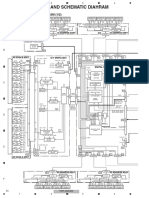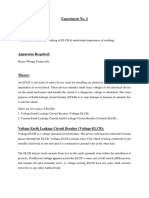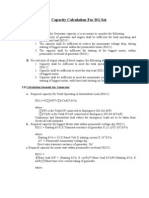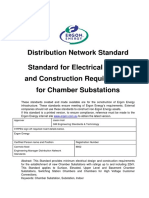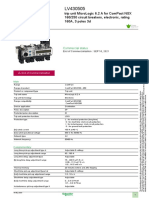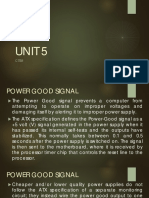Fan 7930
Fan 7930
Uploaded by
sontuyet82Copyright:
Available Formats
Fan 7930
Fan 7930
Uploaded by
sontuyet82Copyright
Available Formats
Share this document
Did you find this document useful?
Is this content inappropriate?
Copyright:
Available Formats
Fan 7930
Fan 7930
Uploaded by
sontuyet82Copyright:
Available Formats
April 2010
2010 Fairchild Semiconductor Corporation www.fairchildsemi.com
FAN7930 Rev. 1.0.1
F
A
N
7
9
3
0
C
r
i
t
i
c
a
l
C
o
n
d
u
c
t
i
o
n
M
o
d
e
P
F
C
C
o
n
t
r
o
l
l
e
r
FAN7930
Critical Conduction Mode PFC Controller
Features
PFC Ready Signal
Input Voltage Absent Detection Circuit
Maximum Switching Frequency Limitation
Internal Soft-Start and Startup without Overshoot
Internal Total Harmonic Distortion (THD) Optimizer
Precise Adjustable Output Over-Voltage Protection
Open-Feedback Protection and Disable Function
Zero Current Detector
150s Internal Startup Timer
MOSFET Over-Current Protection
Under-Voltage Lockout with 3.5V Hysteresis
Low Startup and Operating Current
Totem-Pole Output with High State Clamp
+500/-800mA Peak Gate Drive Current
8-Pin SOP
Applications
Adapter
Ballast
LCD TV, CRT TV
SMPS
Description
The FAN7930 is an active power factor correction (PFC)
controller for boost PFC applications that operate in
critical conduction mode (CRM). It uses a voltage-mode
PWM that compares an internal ramp signal with the
error amplifier output to generate a MOSFET turn-off
signal. Because the voltage-mode CRM PFC controller
does not need rectified AC line voltage information, it
saves the power loss of an input voltage sensing network
necessary for a current-mode CRM PFC controller.
FAN7930 provides over-voltage protection, open-
feedback protection, over-current protection, input-
voltage-absent detection, and under-voltage lockout
protection. The PFC-ready pin can be used to trigger
other power stages when PFC output voltage reaches
the proper level with hysteresis. The FAN7930 can be
disabled if the INV pin voltage is lower than 0.45V and
the operating current decreases to a very low level.
Using a new variable on-time control method, THD is
lower than the conventional CRM boost PFC ICs.
Related Resources
AN-8035 Design Consideration for Boundary
Conduction Mode PFC Using FAN7930
Ordering Information
Part Number
Operating
Temperature
Range
Top Mark Package
Packing
Method
FAN7930M
-40 to +125C FAN7930 8-Lead Small Outline Package (SOP)
Rail
FAN7930MX Tape & Reel
2010 Fairchild Semiconductor Corporation www.fairchildsemi.com
FAN7930 Rev. 1.0.1 2
F
A
N
7
9
3
0
C
r
i
t
i
c
a
l
C
o
n
d
u
c
t
i
o
n
M
o
d
e
P
F
C
C
o
n
t
r
o
l
l
e
r
Application Diagram
Figure 1. Typical Boost PFC Application
Internal Block Diagram
Figure 2. Functional Block Diagram
2010 Fairchild Semiconductor Corporation www.fairchildsemi.com
FAN7930 Rev. 1.0.1 3
F
A
N
7
9
3
0
C
r
i
t
i
c
a
l
C
o
n
d
u
c
t
i
o
n
M
o
d
e
P
F
C
C
o
n
t
r
o
l
l
e
r
Pin Configuration
Figure 3. Pin Configuration (Top View)
Pin Definitions
Pin # Name Description
1 INV
This pin is the inverting input of the error amplifier. The output voltage of the boost PFC converter
should be resistively divided to 2.5V.
2 RDY
This pin is used to detect PFC output voltage reaching a pre-determined value. When output
voltage reaches 89% of rated output voltage, this pin is pulled HIGH, which is an (open drain)
output type.
3 COMP
This pin is the output of the transconductance error amplifier. Components for the output voltage
compensation should be connected between this pin and GND.
4 CS
This pin is the input of the over-current protection comparator. The MOSFET current is sensed
using a sensing resistor and the resulting voltage is applied to this pin. An internal RC filter is
included to filter switching noise.
5 ZCD
This pin is the input of the zero-current detection block. If the voltage of this pin goes higher than
1.5V, then goes lower than 1.4V, the MOSFET is turned on.
6 GND
This pin is used for the ground potential of all the pins. For proper operation, the signal ground
and the power ground should be separated.
7 OUT
This pin is the gate drive output. The peak sourcing and sinking current levels are +500mA and -
800mA, respectively. For proper operation, the stray inductance in the gate driving path must be
minimized.
8 VCC This is the IC supply pin. IC current and MOSFET drive current are supplied using this pin.
2010 Fairchild Semiconductor Corporation www.fairchildsemi.com
FAN7930 Rev. 1.0.1 4
F
A
N
7
9
3
0
C
r
i
t
i
c
a
l
C
o
n
d
u
c
t
i
o
n
M
o
d
e
P
F
C
C
o
n
t
r
o
l
l
e
r
Absolute Maximum Ratings
Stresses exceeding the absolute maximum ratings may damage the device. The device may not function or be
operable above the recommended operating conditions and stressing the parts to these levels is not recommended.
In addition, extended exposure to stresses above the recommended operating conditions may affect device reliability.
The absolute maximum ratings are stress ratings only.
Symbol Parameter Min. Max. Unit
VCC Supply Voltage VZ V
IOH, IOL Peak Drive Output Current -800 +500 mA
ICLAMP Driver Output Clamping Diodes VO>VCC or VO<-0.3V -10 +10 mA
IDET Detector Clamping Diodes -10 +10 mA
VIN
Error Amplifier Input, Output, ZCD and RDY Pin
(1)
-0.3 8.0
V
CS Input Voltage
(2)
-10.0 6.0
TJ Operating Junction Temperature +150 C
TA Operating Temperature Range -40 +125 C
TSTG Storage Temperature Range -65 +150 C
ESD
Electrostatic Discharge
Capability
Human Body Model, JESD22-A114 2.5
kV
Charged Device Model, JESD22-C101 2.0
Notes:
1. When this pin is supplied by external power sources by accident, its maximum allowable current is 50mA.
2. In case of DC input, acceptable input range is -0.3V~6V: within 100ns -10V~6V is acceptable, but electrical
specifications are not guaranteed during such a short time.
Thermal Impedance
Symbol Parameter Min. Max. Unit
JA Thermal Resistance, Junction-to-Ambient
(3)
150 C/W
Note:
3. Regarding the test environment and PCB type, please refer to JESD51-2 and JESD51-10.
2010 Fairchild Semiconductor Corporation www.fairchildsemi.com
FAN7930 Rev. 1.0.1 5
F
A
N
7
9
3
0
C
r
i
t
i
c
a
l
C
o
n
d
u
c
t
i
o
n
M
o
d
e
P
F
C
C
o
n
t
r
o
l
l
e
r
Electrical Characteristics
VCC = 14V, TA = -40C~+125C, unless otherwise specified.
Symbol Parameter Conditions Min. Typ. Max. Units
VCC Section
VSTART Start Threshold Voltage VCC Increasing 11 12 13 V
VSTOP Stop Threshold Voltage VCC Decreasing 7.5 8.5 9.5 V
HYUVLO UVLO Hysteresis 3.0 3.5 4.0 V
VZ Zener Voltage ICC=20mA 20 22 24 V
VOP Recommended Operating Range 13 20 V
Supply Current Section
ISTART Startup Supply Current VCC=VSTART-0.2V 120 190 A
IOP Operating Supply Current Output Not Switching 1.5 3.0 mA
IDOP Dynamic Operating Supply Current 50kHZ, CI=1nF 2.5 4.0 mA
IOPDIS Operating Current at Disable VINV=0V 90 160 230 A
Error Amplifier Section
VREF1 Voltage Feedback Input Threshold1 TA=25C 2.465 2.500 2.535 V
VREF1 Line Regulation VCC=14V~20V 0.1 10.0 mV
VREF2 Temperature Stability of VREF1
(4)
20 mV
IEA,BS Input Bias Current VINV=1V~4V -0.5 0.5 A
IEAS,SR Output Source Current VINV=VREF -0.1V -12 A
IEAS,SK Output Sink Current VINV=VREF +0.1V 12 A
VEAH Output Upper Clamp Voltage VINV=1V, VCS=0V 6.0 6.5 7.0 V
VEAZ Zero Duty Cycle Output Voltage 0.9 1.0 1.1 V
gm Transconductance
(4)
90 115 140 mho
Maximum On-Time Section
tON,MAX1 Maximum On-Time Programming 1 TA=25C, VZCD=1V 35.5 41.5 47.5 s
tON,MAX2 Maximum On-Time Programming 2
TA=25C,
IZCD=0.469mA
11.2 13.0 14.8 s
Current-Sense Section
VCS
Current Sense Input Threshold
Voltage Limit
0.7 0.8 0.9 V
ICS,BS Input Bias Current VCS=0V~1V -1.0 -0.1 1.0 A
tCS,D Current Sense Delay to Output
(4)
dV/dt=1V/100ns, from
0V to 5V
350 500 ns
Continued on the following page
2010 Fairchild Semiconductor Corporation www.fairchildsemi.com
FAN7930 Rev. 1.0.1 6
F
A
N
7
9
3
0
C
r
i
t
i
c
a
l
C
o
n
d
u
c
t
i
o
n
M
o
d
e
P
F
C
C
o
n
t
r
o
l
l
e
r
Electrical Characteristics
VCC = 14V, TA = -40C~+125C, unless otherwise specified.
Symbol Parameter Conditions Min. Typ. Max. Units
Zero-Current Detect Section
VZCD Input Voltage Threshold
(4)
1.35 1.50 1.65 V
HYZCD Detect Hysteresis
(4)
0.05 0.10 0.15 V
VCLAMPH Input High Clamp Voltage IDET=3mA 5.5 6.2 7.5 V
VCLAMPL Input Low Clamp Voltage IDET= -3mA 0 0.65 1.00 V
IZCD,BS Input Bias Current VZCD=1V~5V -1.0 -0.1 1.0 A
IZCD,SR Source Current Capability
(4)
TA=25C -4 mA
IZCD,SK Sink Current Capability
(4)
TA=25C 10 mA
tZCD,D
Maximum Delay From ZCD to Output
Turn-On
(4)
dV/dt=-1V/100ns,
from 5V to 0V
100 200 ns
Output Section
VOH Output Voltage High IO=-100mA, TA=25C 9.2 11.0 12.8 V
VOL Output Voltage Low IO=200mA, TA=25C 1.0 2.5 V
tRISE Rising Time
(4)
CIN=1nF 50 100 ns
tFALL Falling Time
(4)
CIN=1nF 50 100 ns
VO,MAX Maximum Output Voltage VCC=20V, IO=100A 11.5 13.0 14.5 V
VO,UVLO Output Voltage with UVLO Activated VCC=5V, IO=100A 1 V
Restart / Maximum Switching Frequency Limit Section
tRST Restart Timer Delay 50 150 300 s
fMAX Maximum Switching Frequency
(4)
250 300 350 kHz
RDY Pin
IRDY,SK Output Sink Current 1 2 4 mA
VRDY,SAT Output Saturation Voltage IRDY,SK=2mA 320 500 mV
IRDY,LK Output Leakage Current Output High Impedance 1 A
Soft-Start Timer Section
tSS Internal Soft-Soft
(4)
3 5 7 ms
UVLO Section
VRDY Output Ready Voltage 2.185 2.240 2.295 V
HYRDY Output Ready Hysteresis 0.600 V
Protections
VOVP OVP Threshold Voltage TA=25C 2.620 2.675 2.730 V
HYOVP OVP Hysteresis TA=25C 0.120 0.175 0.230 V
VEN Enable Threshold Voltage 0.40 0.45 0.50 V
HYEN Enable Hysteresis 0.050 0.10 0.15 V
TSD Thermal Shutdown Temperature
(4)
125 140 155 C
THYS Hysteresis Temperature of TSD
(4)
60 C
Note:
4. These parameters, although guaranteed by design, are not production tested.
2010 Fairchild Semiconductor Corporation www.fairchildsemi.com
FAN7930 Rev. 1.0.1 7
F
A
N
7
9
3
0
C
r
i
t
i
c
a
l
C
o
n
d
u
c
t
i
o
n
M
o
d
e
P
F
C
C
o
n
t
r
o
l
l
e
r
Comparison of FAN7530 and FAN7930
Function FAN7530 FAN7930 FAN7930 Advantages
PFC Ready Pin None Integrated
No External Circuit for PFC Output UVLO
Reduction of Power Loss and BOM Cost Caused
by PFC Out UVLO Circuit
Open-Drain Pin has Versatile Uses
Frequency Limit None Integrated
Abnormal CCM Operation Prohibited
Abnormal Inductor Current Accumulation can be
Prohibited
AC Absent
Detection
None Integrated
Increase System Reliability with AC On-Off Test
Guarantee Stable Operation at Short Electric
Power Failure
Soft-Start and
Overshoot-less
None Integrated
Reduce Voltage and Current Stress at Startup
Eliminate Audible Noise due to Unwanted OVP
Triggering
THD Optimizer External Internal No External Resistor is Needed
TSD None
140C with 60C
Hysteresis
Stable and Reliable TSD Operation
Converter Temperature Range Limited Range
2010 Fairchild Semiconductor Corporation www.fairchildsemi.com
FAN7930 Rev. 1.0.1 8
F
A
N
7
9
3
0
C
r
i
t
i
c
a
l
C
o
n
d
u
c
t
i
o
n
M
o
d
e
P
F
C
C
o
n
t
r
o
l
l
e
r
Typical Performance Characteristics
Figure 4. Voltage Feedback Input Threshold 1
(VREF1) vs. TA
Figure 5. Start Threshold Voltage (VSTART) vs. TA
Figure 6. Stop Threshold Voltage (VSTOP) vs. TA Figure 7. Startup Supply Current (ISTART) vs. TA
Figure 8. Operating Supply Current (IOP) vs. TA Figure 9. Output Upper Clamp Voltage (VEAH) vs. TA
2010 Fairchild Semiconductor Corporation www.fairchildsemi.com
FAN7930 Rev. 1.0.1 9
F
A
N
7
9
3
0
C
r
i
t
i
c
a
l
C
o
n
d
u
c
t
i
o
n
M
o
d
e
P
F
C
C
o
n
t
r
o
l
l
e
r
Typical Performance Characteristics
Figure 10. Zero Duty Cycle Output Voltage (VEAZ)
vs. TA
Figure 11. Maximum On-Time Program 1 (tON,MAX1)
vs. TA
Figure 12. Maximum On-Time Program 2 (tON,MAX2)
vs. TA
Figure 13. Current Sense Input Threshold Voltage
Limit (VCS) vs. TA
Figure 14. Input High Clamp Voltage (VCLAMPH) vs. TA Figure 15. Input Low Clamp Voltage (VCLAMPL) vs. TA
2010 Fairchild Semiconductor Corporation www.fairchildsemi.com
FAN7930 Rev. 1.0.1 10
F
A
N
7
9
3
0
C
r
i
t
i
c
a
l
C
o
n
d
u
c
t
i
o
n
M
o
d
e
P
F
C
C
o
n
t
r
o
l
l
e
r
Typical Performance Characteristics
Figure 16. Output Voltage High (VOH) vs. TA Figure 17. Output Voltage Low (VOL) vs. TA
Figure 18. Restart Timer Delay (tRST) vs. TA Figure 19. Output Ready Voltage (VRDY) vs. TA
Figure 20. Output Saturation Voltage (VRDY,SAT)
vs. TA
Figure 21. OVP Threshold Voltage (VOVP) vs. TA
2010 Fairchild Semiconductor Corporation www.fairchildsemi.com
FAN7930 Rev. 1.0.1 11
F
A
N
7
9
3
0
C
r
i
t
i
c
a
l
C
o
n
d
u
c
t
i
o
n
M
o
d
e
P
F
C
C
o
n
t
r
o
l
l
e
r
Applications Information
1. Startup: Normally, supply voltage (VCC) of a PFC
block is fed from the additional power supply, which can
be called standby power. Without this standby power,
auxiliary winding to detect zero current detection can be
used as a supply source. Once the supply voltage of the
PFC block exceeds 12V, internal operation is enabled
until the voltage drops to 8.5V. If VCC exceeds VZ, 20mA
current is sinking from VCC.
Figure 22. Startup Circuit
2. INV Block: Scaled-down voltage from the output is
the input for the INV pin. Many functions are embedded
based on the INV pin: transconductance amplifier,
output OVP comparator, disable comparator, and output
UVLO comparator.
For the output voltage control, a transconductance
amplifier is used instead of the conventional voltage
amplifier. The transconductance amplifier (voltage-
controlled current source) aids the implementation of
OVP and disable function. The output current of the
amplifier changes according to the voltage difference of
the inverting and non-inverting input of the amplifier. To
cancel down the line input voltage effect on power factor
correction, effective control response of PFC block
should be slower than the line frequency and this
conflicts with the transient response of controller. Two-
pole one-zero type compensation may be used to meet
both requirements.
The OVP comparator shuts down the output drive block
when the voltage of the INV pin is higher than 2.675V
and there is 0.175V hysteresis. The disable comparator
disables the operation when the voltage of the inverting
input is lower than 0.35V and there is 100mV hysteresis.
An external small-signal MOSFET can be used to
disable the IC, as shown in Figure 23. The IC operating
current decreases to reduce power consumption if the
IC is disabled. Figure 24 is the timing chart of the
internal circuit near the INV pin when rated PFC output
voltage is assumed at 390VDC and VCC supply voltage is
15V.
Figure 23. Circuit Around INV Pin
390Vdc
2.50V
2.65V
0.45V
Current sourcing Current sourcing
I sinking
0.35V
1.64V
2.24V
2.50V
2.0V
349V
413V
390V
256V
70V
55V
VOUT
PFC
VINV
VCC
IOUT
COMP
Disabl e
VRDY
OVP
t
Voltage is decided by pull-up voltage.
Vcc<2V, internal logic is not alive.
- RDY pin is floating, so pull up voltage is shown.
- Internal signals are unknown.
15V
Figure 24. Timing Chart for INV Block
3. RDY Output: When the INV voltage is higher than
2.24V, output UVLO voltage is triggered to high and
lasts until the INV voltage is lower than 1.64V. This
signal outputs through the RDY pin. RDY pin output is
open-drain type, so needs an external pull-up resistor to
supply the proper power source. The RDY pin output
remains floating until VCC is higher than 2V.
2010 Fairchild Semiconductor Corporation www.fairchildsemi.com
FAN7930 Rev. 1.0.1 12
F
A
N
7
9
3
0
C
r
i
t
i
c
a
l
C
o
n
d
u
c
t
i
o
n
M
o
d
e
P
F
C
C
o
n
t
r
o
l
l
e
r
4. Zero-Current Detection: Zero-current detection
(ZCD) generates the turn-on signal of the MOSFET
when the boost inductor current reaches zero using an
auxiliary winding coupled with the inductor. When the
power switch turns on, negative voltage is induced at the
auxiliary winding due to the opposite winding direction
(see equation 1) and positive voltage is induced (see
equation 2) when the power switch turns off.
AC
IND
AUX
AUX
V
T
T
V =
(1)
( )
AC PFCOUT
IND
AUX
AUX
V V
T
T
V =
(2)
where, VAUX is the auxiliary winding voltage, TIND and
TAUX are boost inductor turns and auxiliary winding turns
respectively, VAC is input voltage for PFC converter and
VOUT_PFC is output voltage from the PFC converter.
Figure 25. Circuit Near ZCD
Because auxiliary winding voltage can swing from
negative voltage to positive voltage, the internal block in
ZCD pin has both positive and negative voltage
clamping circuits. When the auxiliary voltage is
negative, internal circuit clamps the negative voltage at
the ZCD pin around 0.65V by sourcing current to the
serial resistor between the ZCD pin and the auxiliary
winding. When the auxiliary voltage is higher than 6.5V,
current is sinked through a resistor from the auxiliary
winding to the ZCD pin.
Figure 26. Auxiliary Voltage Depends
on MOSFET Switching
To check the boost inductor current zero instance,
auxiliary winding voltage is used. When boost inductor
current becomes zero, there is a resonance between
boost inductor and all capacitors at MOSFET drain pin,
including COSS of the MOSFET; an external capacitor at
the D-S pin to reduce the voltage rising and falling slope
of the MOSFET; a parasitic capacitor at inductor; and so
on to improve performance. Resonated voltage is
reflected to the auxiliary winding and can be used as
detecting zero current of boost inductor and valley
position of MOSFET voltage stress. For valley detection,
a minor delay by the resistor and capacitor is needed. A
capacitor increases the noise immunity at the ZCD pin.
If ZCD voltage is higher than 1.5V, an internal ZCD
comparator output becomes HIGH and LOW when the
ZCD goes below 1.4V. At the falling edge of comparator
output, internal logic turns on the MOSFET.
Figure 27. Auxiliary Voltage Threshold
When no ZCD signal is available, the PFC controller
cannot turn on MOSFET, so the controller checks every
switching off time and forces MOSFET turn on when the
off time is longer than 150s. It is called restart timer.
Restart timer triggers MOSFET turn on at startup and
may be used at the input voltage zero cross period.
s 150
Figure 28. Restart Timer at Startup
2010 Fairchild Semiconductor Corporation www.fairchildsemi.com
FAN7930 Rev. 1.0.1 13
F
A
N
7
9
3
0
C
r
i
t
i
c
a
l
C
o
n
d
u
c
t
i
o
n
M
o
d
e
P
F
C
C
o
n
t
r
o
l
l
e
r
Because the MOSFET turn on depends on the ZCD
input, switching frequency may increase to higher than
several megahertz due to the miss-triggering or noise
on the nearby ZCD pin. If the switching frequency is
higher than needed for critical conduction mode (CRM),
operation mode shifts to continuous conduction mode
(CCM). In CCM, unlike CRM where the boost inductor
current is reset to zero at the next switch on; inductor
current builds up at every switching cycle and can be
raised to very high current, that exceeds the current
rating of the power switch or diode. This can seriously
damage the power switch and result in burn down. To
avoid this, maximum switching frequency limitation is
embedded. If ZCD signal is applied again within 3.3s
after the previous rising edge of gate signal, this signal
is ignored internally and FAN7930 waits for another
ZCD signal. This slightly degrades the power factor
performance at light load and high input voltage.
Figure 29. Maximum Switching Frequency
Limit Operation
5. Control: The scaled output is compared with the
internal reference voltage and sinking or sourcing
current is generated from the COMP pin by the
transconductance amplifier. The error amplifier output is
compared with the internal sawtooth waveform to give
proper turn-on time based on the controller.
Figure 30. Control Circuit
Unlike a conventional voltage-mode PWM controller,
FAN7930 turns on the MOSFET at the falling edge of
ZCD signal. On instance is decided by the external
signal and the turn-on time lasts until the error amplifier
output (VCOMP) and sawtooth waveform meet. When
load is heavy, output voltage decreases, scaled output
decreases, COMP voltage increases to compensate low
output, turn-on time lengthens to give more inductor
turn-on time, and increased inductor current raises the
output voltage. This is how PFC negative feedback
controller regulates output.
The maximum of VCOMP is limited to 6.5V, which dictates
the maximum turn-on time, and switching stops when
VCOMP is lower than 1.0V.
s / V 155 . 0
Figure 31. Turn-On Time Determination
The roles of PFC controller are regulating output voltage
and input current shaping to increase power factor. Duty
control based on the output voltage should be fast
enough to compensate output voltage dip or overshoot.
For the power factor, however, the control loop must not
react to the fluctuating AC input voltage. These two
requirements conflict; therefore, when designing a
feedback loop, the feedback loop should be least 10
times slower than AC line frequency. That slow
response is made by C1 at compensator. R1 makes
gain boost around operation region and C2 attenuates
gain at higher frequency. Boost gain by R1 helps raise
the response time and improves phase margin.
Figure 32. Compensators Gain Curve
For the transconductance error amplifier side, gain
changes based on differential input. When the error is
large, gain is large to make the output dip or peak to
suppress quickly. When the error is small, low gain is
used to improve power factor performance.
2010 Fairchild Semiconductor Corporation www.fairchildsemi.com
FAN7930 Rev. 1.0.1 14
F
A
N
7
9
3
0
C
r
i
t
i
c
a
l
C
o
n
d
u
c
t
i
o
n
M
o
d
e
P
F
C
C
o
n
t
r
o
l
l
e
r
mho 250
mho 115
Figure 33. Gain Characteristic
6. Soft-Start: When VCC touches VSTART, internal
reference voltage is increased like a stair step for 5ms.
As a result, VCOMP is also raised gradually and MOSFET
turn-on time increases smoothly. This reduces voltage
and current stress on the power switch during startup.
Figure 34. Soft-Start Sequence
7. Overshoot-less Startup: Feedback control speed
of PFC is quite slow. Due to the slow response, there is
a gap between output voltage and feedback control.
That is why over-voltage protection (OVP) is critical at
the PFC controller and voltage dip caused by fast load
changes from light to heavy is diminished by a bulk
capacitor. OVP is easily triggered at startup phase.
Operation on and off by OVP at startup may cause
audible noise and can increase voltage stress at startup,
which is normally higher than in normal operation. This
operation is better when soft-start time is very long.
However, too long startup time enlarges the output
voltage building time at light load. FAN7930 has
overshoot-less control at startup. During startup, the
feedback loop is controlled by an internal proportional
gain controller and when the output voltage reaches the
rated value, it switches to an external compensator after
a transition time of 30ms. In short, an internal
proportional gain controller eliminates overshoot at
startup and an external conventional compensator takes
over successfully afterward.
Figure 35. Overshoot-less Startup Control
8. THD Optimization: Total harmonic distortion (THD)
is the factor that dictates how closely input current
shape matches sinusoidal form. The turn-on time of the
PFC controller is almost constant over one AC line
period due to the extremely low feedback control
response. The turn-off time is decided by the current
decrease slope of the boost inductor made by the input
voltage and output voltage. Once inductor current
becomes zero, resonance between COSS and the boost
inductor makes oscillating waveforms at the drain pin
and auxiliary winding. By checking the auxiliary winding
voltage through the ZCD pin, the controller can check
the zero current of boost inductor. At the same time, a
minor delay time is inserted to determine the valley
position of drain voltage. The input and output voltage
difference is at its maximum at the zero cross point of
AC input voltage. The current decrease slope is steep
near the zero cross region and more negative inductor
current flows during a drain voltage valley detection
time. Such a negative inductor current cancels down the
positive current flows and input current becomes zero,
called zero-cross distortion in PFC.
2010 Fairchild Semiconductor Corporation www.fairchildsemi.com
FAN7930 Rev. 1.0.1 15
F
A
N
7
9
3
0
C
r
i
t
i
c
a
l
C
o
n
d
u
c
t
i
o
n
M
o
d
e
P
F
C
C
o
n
t
r
o
l
l
e
r
1.5V
150ns
1.4V
ON
FAN7930 Rev.00
VZCD
t
IINDUCTOR
MOSFET gate
INEGATIVE
ON
IIN
IMOSFET
IDIODE
Figure 36. Input and Output Current Near Input
Voltage Peak
Figure 37. Input and Output Current Near Input
Voltage Peak Zero Cross
To improve this, lengthened turn-on time near the zero
cross region is a well-known technique, though the
method may be different from company to company and
may be proprietary. FAN7930 emdodies this by sourcing
current through the ZCD pin. Auxiliary winding voltage
becomes negative when the MOSFET turns on and is
proportional to input voltage. The negative clamping
circuit of ZCD outputs the current to maintain the ZCD
voltage at a fixed value. The sourcing current from the
ZCD is directly proportional to the input voltage. Some
portion of this current is applied to the internal sawtooth
generator together with a fixed-current source.
Theoretically, the fixed-current source and the capacitor
at sawtooth generator decide the maximum turn-on time
when no current is sourcing at ZCD clamp circuit and
available turn-on time gets shorter proportional to the
ZCD sourcing current.
Figure 38. Circuit of THD Optimizer
Figure 39. Effect of THD Optimizer
By THD optimizer, turn-on time over one AC line period
is proportionally changed, depending on input voltage.
Near zero cross, lengthened turn-on time improves THD
performance.
9. Input Voltage Absent Detection: To save power
loss caused by input voltage sensing resistors and to
optimize THD easily, the FAN7930 omits AC input
voltage detection. Therefore, no information about AC
input is available from the internal controller. In many
cases, the VCC of PFC controller is supplied by a
independent power source like standby power. In this
scheme, some mismatch may exist. For example, when
the electric power is suddenly interrupted during two or
three AC line periods; VCC is still alive during that time,
but output voltage drops because there is no input
power source. Consequently, the control loop tries to
compensate for the output voltage drop and VCOMP
reaches its maximum. This lasts until AC input voltage is
2010 Fairchild Semiconductor Corporation www.fairchildsemi.com
FAN7930 Rev. 1.0.1 16
F
A
N
7
9
3
0
C
r
i
t
i
c
a
l
C
o
n
d
u
c
t
i
o
n
M
o
d
e
P
F
C
C
o
n
t
r
o
l
l
e
r
live again. When AC input voltage is live again, high
VCOMP allows high switching current and more stress is
put on the MOSFET and diode. To protect against this,
FAN7930 internally checks if the input AC voltage
exists. If input does not exist, soft-start is reset and
waits until AC input is live again. Soft-start manages the
turn-on time for smooth operation when it detects AC
input is applied again and applies less voltage and
current stress on startup.
Figure 40. Operation without Input Voltage
Absent Circuit
Figure 41. Operation with Input Voltage
Absent Circuit
10. Current Sense: The MOSFET current is sensed
using an external sensing resistor for the over-current
protection. If the CS pin voltage is higher than 0.8V, the
over-current protection comparator generates a
protection signal. An internal RC filter of 40k and 8pF
is included to filter switching noise.
11. Gate Driver Output: FAN7930 contains a single
totem-pole output stage designed for a direct drive of
the power MOSFET. The drive output is capable of up
to +500/-800mA peak current with a typical rise and fall
time of 50ns with 1nF load. The output voltage is
clamped to 13V to protect the MOSFET gate even if the
VCC voltage is higher than 13V.
2010 Fairchild Semiconductor Corporation www.fairchildsemi.com
FAN7930 Rev. 1.0.1 17
F
A
N
7
9
3
0
C
r
i
t
i
c
a
l
C
o
n
d
u
c
t
i
o
n
M
o
d
e
P
F
C
C
o
n
t
r
o
l
l
e
r
PCB Layout Guide
PFC block normally handles high switching current and
the voltage low energy signal path can be affected by
the high energy path. Cautious PCB layout is mandatory
for stable operation.
1. The gate drive path should be as short as possible.
The closed-loop that starts from the gate driver,
MOSFET gate, and MOSFET source to ground of
PFC controller is recommended as close as
possible. This is also crossing point between power
ground and signal ground. Power ground path from
the bridge diode to the output bulk capacitor should
be short and wide. The sharing position between
power ground and signal ground should be only at
one position to avoid ground loop noise. Signal path
of PFC controller should be short and wide for
external components to contact.
2. PFC output voltage sensing resistor is normally
high to reduce current consumption. This path can
be affected by external noise. To reduce noise
possibility at the INV pin, a shorter path for output
sensing is recommended. If a shorter path is not
possible, place some dividing resistors between
PFC output and the INV pin closer to the INV pin
is better. Relative high voltage close to the INV pin
can be helpful.
3. ZCD path is recommended close to auxiliary
winding from boost inductor and to the ZCD pin. If
that is difficult, place a small capacitor (below 50pF)
to reduce noise.
4. Switching current sense path should not share with
another path to avoid interference. Some additional
components may be needed to reduce the noise
level applied to the CS pin.
5. A stabilizing capacitor for VCC is recommended as
close as possible to the VCC and ground pins. If it is
difficult, place the SMD capacitor as close to the
corresponding pins as possible.
Figure 42. Recommended PCB Layout
2010 Fairchild Semiconductor Corporation www.fairchildsemi.com
FAN7930 Rev. 1.0.1 18
F
A
N
7
9
3
0
C
r
i
t
i
c
a
l
C
o
n
d
u
c
t
i
o
n
M
o
d
e
P
F
C
C
o
n
t
r
o
l
l
e
r
Typical Application Circuit
Application Device
Input Voltage
Range
Rated Output
Power
Output Voltage
(Maximum
Current)
LCD TV Power Supply FAN7930 90-265VAC 195W 390V (0.5A)
Features
Average efficiency of 25%, 50%, 75%, and 100% load conditions is higher than 95% at universal input.
Power factor at rated load is higher than 0.98 at universal input.
Total Harmonic Distortion (THD) at rated load is lower than 15% at universal input.
Key Design Notes
When auxiliary VCC supply is not available, VCC power can be supplied through Zero Current Detect (ZCD)
winding. The power consumption of R103 is quite high, so its power rating needs checking.
Because the input bias current of INV pin is almost zero, output voltage sensing resistors (R112~R115) as high
as possible. However, too-high resistance makes the node easily affected by noise. Thus values need to strike a
balance between power consumption and noise immunity.
Quick charge diode (D106) can be eliminated. Without D106, system operation is normal due to the controllers
highly reliable protection features.
1. Schematic
Figure 43. Demonstration Circuit
2010 Fairchild Semiconductor Corporation www.fairchildsemi.com
FAN7930 Rev. 1.0.1 19
F
A
N
7
9
3
0
C
r
i
t
i
c
a
l
C
o
n
d
u
c
t
i
o
n
M
o
d
e
P
F
C
C
o
n
t
r
o
l
l
e
r
2. Transformer
Figure 44. Transformer Schematic Diagram of FAN7930
3. Winding Specification
Position No Pin (S F) Wire Turns
Winding
Method
Barrier Tape
TOP BOT Ts
Bottom
Np 9, 10 7, 8 0.150 49 Solenoid Winding 1
Insulation: Polyester Tape t = 0.025mm, 3 Layers
Top
NAUX 2 4 0.3 6 Solenoid Winding
Insulation: Polyester Tape t = 0.025mm, 4 Layers
4. Electrical Characteristics
Pin Specification Remark
Inductance 9, 10 7, 8 230H 7% 100kHz, 1V
5. Core & Bobbin
Core: EER3124, Samhwa (PL-7) (Ae=97.9mm
2
)
Bobbin: EER3124
2010 Fairchild Semiconductor Corporation www.fairchildsemi.com
FAN7930 Rev. 1.0.1 20
F
A
N
7
9
3
0
C
r
i
t
i
c
a
l
C
o
n
d
u
c
t
i
o
n
M
o
d
e
P
F
C
C
o
n
t
r
o
l
l
e
r
6. Bill of Materials
Part # Value Note Part # Value Note
Resister Switch
R101 1M 1W Q101 FCPF20N60 20A, 600V, SuperFET
R102 330k 1/2W Diode
R103 10k 1W D101 1N4746 1W, 18V, Zener Diode
R104
30k 1/4W D102 UF4004
1A, 400V Glass Passivated
High-Efficiency Rectifier
R107 10k 1/4W D103 1N4148 1A, 100V Small-Signal Diode
R108 4.7k 1/4W D104 1N4148 1A, 100V Small-Signal Diode
R109
47k
1/4W
D105
8A, 600V, General-Purpose
Rectifier
R110
10k
1/4W
D106
3A, 600V, General-Purpose
Rectifier
R111 0.80k 5W
R112, 113, 114 3.9k 1/4W IC101 FAN7930 CRM PFC Controller
R115 75k 1/4W
Capacitor Fuse
C101 220nF/275VAC Box Capacitor FS101 5A/250V
C102 680nF/275VAC Box Capacitor NTC
C103 0.68F/630V Box Capacitor TH101 5D-15
C104 12nF/50V Ceramic Capacitor Bridge Diode
C105 100nF/50V SMD (1206) BD101 15A, 600V
C107 33F/50V Electrolytic Capacitor Line Filter
C108 220nF/50V Ceramic Capacitor LF101 23mH
C109 47nF/50V Ceramic Capacitor Transformer
C110 1nF/50V Ceramic Capacitor T1 EER3124 Ae=97.9mm
2
C112 47nF/50V Ceramic Capacitor ZNR
C111 220F/450V Electrolytic Capacitor ZNR101 10D471
C114 2.2nF/450V Box Capacitor
C115 2.2nF/450V Box Capacitor
2010 Fairchild Semiconductor Corporation www.fairchildsemi.com
FAN7930 Rev. 1.0.1 21
F
A
N
7
9
3
0
C
r
i
t
i
c
a
l
C
o
n
d
u
c
t
i
o
n
M
o
d
e
P
F
C
C
o
n
t
r
o
l
l
e
r
Physical Dimensions
Figure 45. 8-Lead Small Outline Package (SOP)
Package drawings are provided as a service to customers considering Fairchild components. Drawings may change in any manner
without notice. Please note the revision and/or date on the drawing and contact a Fairchild Semiconductor representative to verify or
obtain the most recent revision. Package specifications do not expand the terms of Fairchilds worldwide terms and conditions, specifically the
warranty therein, which covers Fairchild products.
Always visit Fairchild Semiconductors online packaging area for the most recent package drawings:
http://www.fairchildsemi.com/packaging/.
8
0
SEE DETAIL A
NOTES: UNLESS OTHERWISE SPECIFIED
A) THIS PACKAGE CONFORMS TO JEDEC
MS-012, VARIATION AA, ISSUE C,
B) ALL DIMENSIONS ARE IN MILLIMETERS.
C) DIMENSIONS DO NOT INCLUDE MOLD
FLASH OR BURRS.
D) LANDPATTERN STANDARD: SOIC127P600X175-8M.
E) DRAWING FILENAME: M08AREV13
LAND PATTERN RECOMMENDATION
SEATING PLANE
C
GAGE PLANE
x 45
DETAIL A
SCALE: 2:1
PIN ONE
INDICATOR
4
8
1
B
5
A
5.60
0.65
1.75
1.27
6.20
5.80
3.81
4.00
3.80
5.00
4.80
(0.33)
1.27
0.51
0.33
0.25
0.10
1.75 MAX
0.25
0.19
0.36
0.50
0.25
R0.10
R0.10
0.90
0.40
(1.04)
OPTION A - BEVEL EDGE
OPTION B - NO BEVEL EDGE
0.25 C B A
0.10 C
2010 Fairchild Semiconductor Corporation www.fairchildsemi.com
FAN7930 Rev. 1.0.1 22
F
A
N
7
9
3
0
C
r
i
t
i
c
a
l
C
o
n
d
u
c
t
i
o
n
M
o
d
e
P
F
C
C
o
n
t
r
o
l
l
e
r
You might also like
- The Subtle Art of Not Giving a F*ck: A Counterintuitive Approach to Living a Good LifeFrom EverandThe Subtle Art of Not Giving a F*ck: A Counterintuitive Approach to Living a Good LifeRating: 4 out of 5 stars4/5 (5982)
- The Gifts of Imperfection: Let Go of Who You Think You're Supposed to Be and Embrace Who You AreFrom EverandThe Gifts of Imperfection: Let Go of Who You Think You're Supposed to Be and Embrace Who You AreRating: 4 out of 5 stars4/5 (1112)
- Never Split the Difference: Negotiating As If Your Life Depended On ItFrom EverandNever Split the Difference: Negotiating As If Your Life Depended On ItRating: 4.5 out of 5 stars4.5/5 (898)
- Hidden Figures: The American Dream and the Untold Story of the Black Women Mathematicians Who Helped Win the Space RaceFrom EverandHidden Figures: The American Dream and the Untold Story of the Black Women Mathematicians Who Helped Win the Space RaceRating: 4 out of 5 stars4/5 (932)
- Grit: The Power of Passion and PerseveranceFrom EverandGrit: The Power of Passion and PerseveranceRating: 4 out of 5 stars4/5 (619)
- Shoe Dog: A Memoir by the Creator of NikeFrom EverandShoe Dog: A Memoir by the Creator of NikeRating: 4.5 out of 5 stars4.5/5 (546)
- The Hard Thing About Hard Things: Building a Business When There Are No Easy AnswersFrom EverandThe Hard Thing About Hard Things: Building a Business When There Are No Easy AnswersRating: 4.5 out of 5 stars4.5/5 (357)
- Her Body and Other Parties: StoriesFrom EverandHer Body and Other Parties: StoriesRating: 4 out of 5 stars4/5 (831)
- Elon Musk: Tesla, SpaceX, and the Quest for a Fantastic FutureFrom EverandElon Musk: Tesla, SpaceX, and the Quest for a Fantastic FutureRating: 4.5 out of 5 stars4.5/5 (476)
- The Emperor of All Maladies: A Biography of CancerFrom EverandThe Emperor of All Maladies: A Biography of CancerRating: 4.5 out of 5 stars4.5/5 (275)
- The Little Book of Hygge: Danish Secrets to Happy LivingFrom EverandThe Little Book of Hygge: Danish Secrets to Happy LivingRating: 3.5 out of 5 stars3.5/5 (425)
- The World Is Flat 3.0: A Brief History of the Twenty-first CenturyFrom EverandThe World Is Flat 3.0: A Brief History of the Twenty-first CenturyRating: 3.5 out of 5 stars3.5/5 (2272)
- The Yellow House: A Memoir (2019 National Book Award Winner)From EverandThe Yellow House: A Memoir (2019 National Book Award Winner)Rating: 4 out of 5 stars4/5 (99)
- The Sympathizer: A Novel (Pulitzer Prize for Fiction)From EverandThe Sympathizer: A Novel (Pulitzer Prize for Fiction)Rating: 4.5 out of 5 stars4.5/5 (125)
- Devil in the Grove: Thurgood Marshall, the Groveland Boys, and the Dawn of a New AmericaFrom EverandDevil in the Grove: Thurgood Marshall, the Groveland Boys, and the Dawn of a New AmericaRating: 4.5 out of 5 stars4.5/5 (270)
- Team of Rivals: The Political Genius of Abraham LincolnFrom EverandTeam of Rivals: The Political Genius of Abraham LincolnRating: 4.5 out of 5 stars4.5/5 (235)
- A Heartbreaking Work Of Staggering Genius: A Memoir Based on a True StoryFrom EverandA Heartbreaking Work Of Staggering Genius: A Memoir Based on a True StoryRating: 3.5 out of 5 stars3.5/5 (232)
- On Fire: The (Burning) Case for a Green New DealFrom EverandOn Fire: The (Burning) Case for a Green New DealRating: 4 out of 5 stars4/5 (75)
- DV29 Service Manual Issue 1 PDFDocument48 pagesDV29 Service Manual Issue 1 PDFZbigniew SzaryczNo ratings yet
- The Unwinding: An Inner History of the New AmericaFrom EverandThe Unwinding: An Inner History of the New AmericaRating: 4 out of 5 stars4/5 (45)
- 239716035Document25 pages239716035sontuyet82No ratings yet
- Technical Data & Service Manual: Indoor Unit: As52AlDocument31 pagesTechnical Data & Service Manual: Indoor Unit: As52Alsontuyet82No ratings yet
- Deflection YokeDocument2 pagesDeflection Yokesontuyet82No ratings yet
- NN Se992s NN Sd982s NN St962s Panasonic 1680Document38 pagesNN Se992s NN Sd982s NN St962s Panasonic 1680sontuyet82No ratings yet
- C781 - Ser - MSG-18HRDN1-QC2 - B - V1Document38 pagesC781 - Ser - MSG-18HRDN1-QC2 - B - V1sontuyet82No ratings yet
- Mitsubishi Special Price Spares List 161111Document8 pagesMitsubishi Special Price Spares List 161111sontuyet82No ratings yet
- Karaoke Circuit Building InstructionsDocument10 pagesKaraoke Circuit Building Instructionssontuyet82No ratings yet
- IM 1222 SC Supplement Canary WharfDocument14 pagesIM 1222 SC Supplement Canary Wharfsontuyet82No ratings yet
- Public Media 2013920820520.005400 S07AHPDocument41 pagesPublic Media 2013920820520.005400 S07AHPsontuyet82No ratings yet
- Speaker Protection CircuitDocument3 pagesSpeaker Protection Circuitsontuyet820% (2)
- MPEG-4 HD Single Chip iDTV IC: Emma3TlDocument2 pagesMPEG-4 HD Single Chip iDTV IC: Emma3Tlsontuyet82No ratings yet
- Proson RV 2040 Service ManualDocument22 pagesProson RV 2040 Service Manualsontuyet82No ratings yet
- Clevo tn120rDocument90 pagesClevo tn120rsontuyet82No ratings yet
- LH-C6230P C6231PDocument114 pagesLH-C6230P C6231Psontuyet82No ratings yet
- MC1723 PDFDocument9 pagesMC1723 PDFOsman KoçakNo ratings yet
- FSFR1800Document17 pagesFSFR1800sontuyet82No ratings yet
- AOC Inverter SCHDocument4 pagesAOC Inverter SCHMarincus AdrianNo ratings yet
- LED Flashing Specification at The Time of The Error: LC-40/46/52LE820E (1st Edition)Document4 pagesLED Flashing Specification at The Time of The Error: LC-40/46/52LE820E (1st Edition)sontuyet82No ratings yet
- STM Green Model SMPS Solution For High Power SLIM AdaptorDocument35 pagesSTM Green Model SMPS Solution For High Power SLIM Adaptorsontuyet82No ratings yet
- ICX618ALA: Diagonal 4.5mm (Type 1/4) Progressive Scan CCD Image Sensor With Square Pixel For B/W CamerasDocument20 pagesICX618ALA: Diagonal 4.5mm (Type 1/4) Progressive Scan CCD Image Sensor With Square Pixel For B/W Camerassontuyet82No ratings yet
- VentilationDocument14 pagesVentilationevansparrowNo ratings yet
- ELCB ExperimentDocument4 pagesELCB ExperimentShubham Singh RathoreNo ratings yet
- Spec Sheet MTU 16V4000 DS2250 FC PDFDocument6 pagesSpec Sheet MTU 16V4000 DS2250 FC PDFMarison SaragihNo ratings yet
- HVDC Cooling Systems White PaperDocument13 pagesHVDC Cooling Systems White PaperHimanshu MisNo ratings yet
- DG Set Cap CalDocument2 pagesDG Set Cap Calshashi495100% (1)
- Weekly Programmable Electronic Timer DHC15Document2 pagesWeekly Programmable Electronic Timer DHC15Marc CMNo ratings yet
- CTPT Price List ProductPriceDocument11 pagesCTPT Price List ProductPriceParamjeet singhNo ratings yet
- Device Library List 2000 PDFDocument248 pagesDevice Library List 2000 PDFNuru TwahaNo ratings yet
- Catalog 12 PagesDocument12 pagesCatalog 12 PagesueksinNo ratings yet
- Ee 501Document2 pagesEe 501Sara PowersNo ratings yet
- Build This Stun-GunDocument6 pagesBuild This Stun-GunagustinzmNo ratings yet
- SL No. Projects in SCP Cost (Rs. in Crore) Area Based Development (ABD) List of Projects As Per Smart City Proposal: Kalyan-DombivaliDocument1 pageSL No. Projects in SCP Cost (Rs. in Crore) Area Based Development (ABD) List of Projects As Per Smart City Proposal: Kalyan-DombivaliAbhishek Kumar100% (1)
- 10A 30A PWM Solar Charge Controller ManualDocument5 pages10A 30A PWM Solar Charge Controller ManualReid StephensNo ratings yet
- DC Motor Calculations 2004Document27 pagesDC Motor Calculations 2004erkamlakar2234No ratings yet
- Csa PX2K A2 A2f A2frc A2f-Fc SS2K P2KDocument2 pagesCsa PX2K A2 A2f A2frc A2f-Fc SS2K P2KsupaG013No ratings yet
- S2u Operating Instructions Vec1060r0Document120 pagesS2u Operating Instructions Vec1060r0Felipe Ferreira100% (1)
- Chapter 2Document16 pagesChapter 2irvan1173No ratings yet
- Module 5 Lesson 3Document21 pagesModule 5 Lesson 3IceNo ratings yet
- STNW3389 PDFDocument32 pagesSTNW3389 PDFMehdi Salah100% (1)
- LT 8711Document38 pagesLT 8711MallikarjunBhiradeNo ratings yet
- Homer Lab 04Document9 pagesHomer Lab 04DiegoFernandoRojasTorresNo ratings yet
- KP D28PDocument5 pagesKP D28PDerek ChenNo ratings yet
- Porta Fusible Canister para 34.5 KVDocument24 pagesPorta Fusible Canister para 34.5 KVjryamNo ratings yet
- LIST MATERIAL Retrofit LCCDocument6 pagesLIST MATERIAL Retrofit LCCUkas RiyupiNo ratings yet
- LV430505 - DATASHEET - WW - en-GB - MIC 6.2 - 160ADocument2 pagesLV430505 - DATASHEET - WW - en-GB - MIC 6.2 - 160ASenthil SankarasubramanianNo ratings yet
- Unit 5 - CTSMDocument18 pagesUnit 5 - CTSMGaurav Kumar SinghNo ratings yet
- 5 Electricity Test AnswersDocument4 pages5 Electricity Test AnswersnajehNo ratings yet
- Ssam sSAM Pinning List: Next Generation CascadiaDocument1 pageSsam sSAM Pinning List: Next Generation CascadiaManuel SolarNo ratings yet
- ISL6255, ISL6255A: Highly Integrated Battery Charger With Automatic Power Source Selector For Notebook Computers FeaturesDocument22 pagesISL6255, ISL6255A: Highly Integrated Battery Charger With Automatic Power Source Selector For Notebook Computers FeaturesEveraldoNo ratings yet









































